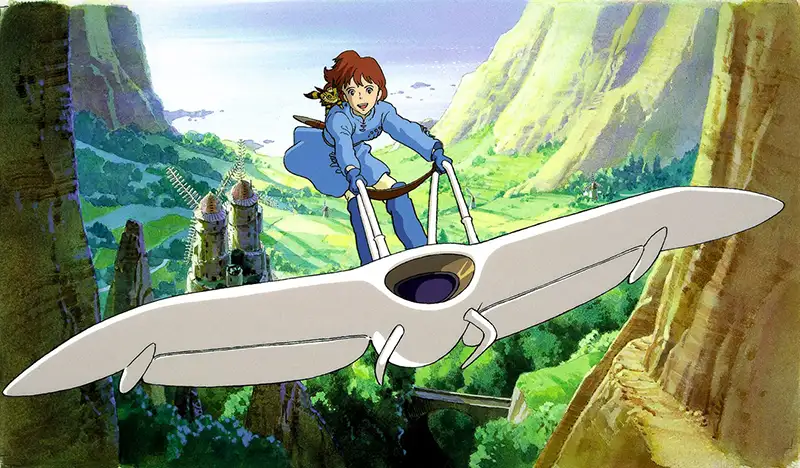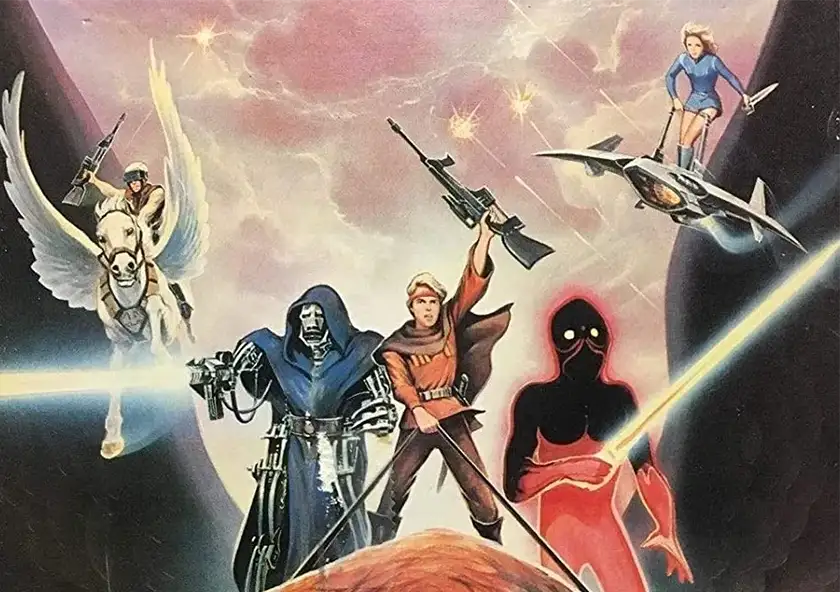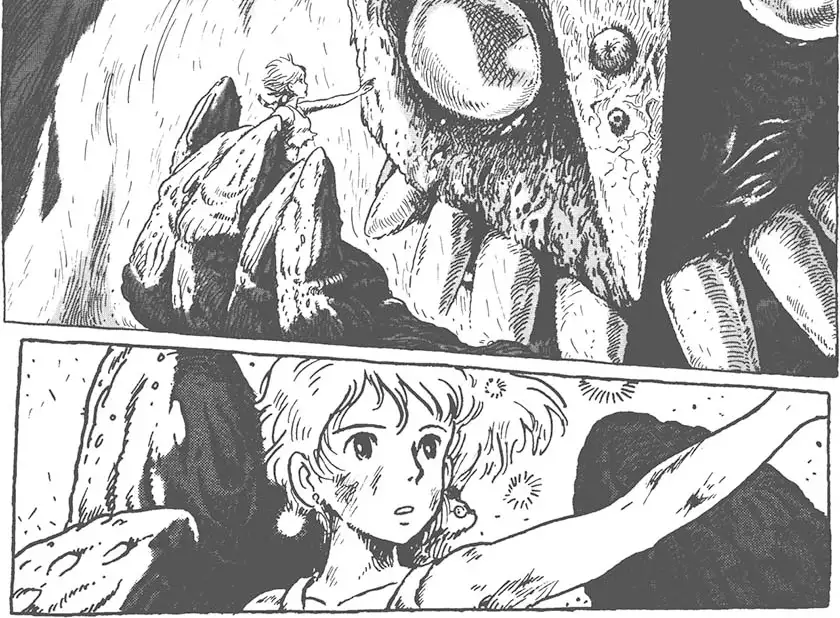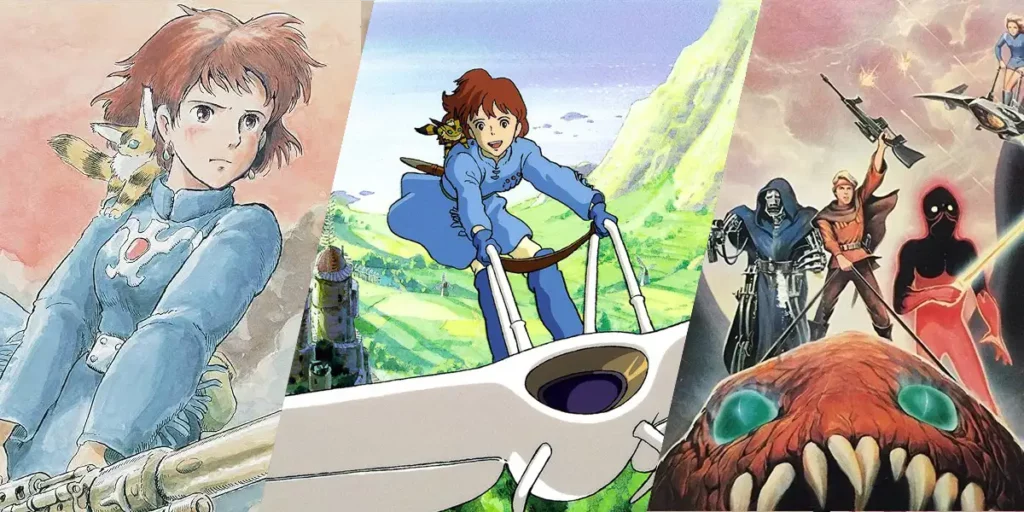Three versions of Hayao Miyazaki’s Nausicaä of the Valley of the Wind exist, including the manga and the 1985 re-relase, Here’s how the director’s vision changed based on their context and medium.
Kaze no Tani no Nashika, more commonly known as Nausicaä of the Valley of the Wind, is a certified classic, lauded by critics and audiences alike. However, a common misconception I’ve seen with those people is that they call Nausicaä a completely original movie, which is far from the case. When most people talk about Nausicaa, they are referring to the 1984 animated movie by Hayao Miyazaki.
Nausicaä of the Valley of the Wind follows the titular character Nausicaä (Shimamoto Sumi) in a ruined world filled with poisonous flora and giant insects, where its residents struggle to survive day to day. This was back before Miyazaki’s Studio Ghibli was established, but it’s often seen as his starting point considering its popularity and acclaim. In reality, though, the movie was actually based off the first two volumes of a manga Miyazaki started two years prior. In addition, a third version exists: a heavily edited copy distributed for the US in 1985, called Warriors The Wind.
We will go through one version at a time; all of them sport the same post-apocalyptic premise and contain themes related to life, nature, and humanity, most likely born out of years of pollution and activism in Japan. Yet their approaches to those themes were changed due to the difference in their historical context and also the medium itself, going as far as to create completely different characters or plotlines. And that’s the main question for today. What were those changes and how does that alter each version’s focus on nature? Moreover, what were the reasons for those changes in the first place?
Nausicaä of the Valley of the Wind (1984)

Once, humanity waged an apocalyptic war amongst each other known as the Seven Days of Fire. The event wiped out all advanced civilization on the planet. Moreover, it created the fukai, a toxic jungle that constantly spews out a miasma that infects nearby plants and accumulates in people’s body, killing them in as little as five minutes. The survivors are unable to do much about the fukai, as it is swarming with giant mutated insects, including the omu, armored creatures that attack ferociously in response to any attempts at harming the forest or its creatures. That is the world Nausicaä of the Valley of the Wind takes place in: an unfamiliar, frightening place.
But that’s not how the movie’s opening portrays it. As Nausicaä explores the jungle, while the environment is certainly alien, it is accompanied by a delicate, calming shade of blue and serene music. Even the toxic miasma falling down on Nausicaä appear like snow, creating an almost magical moment devoid of malice. Those few minutes already show what the movie is trying to say about nature. It can be harmful or threatening, but it only becomes so in relation to humanity. When left to its own devices, the ecosystem keeps going without clear good or ill will.
This is reinforced visually throughout the movie, with landscape of the fukai often drawn in cool shades, creating a more peaceful atmosphere that contrasts with the fiery red and harsh gray of the humans. We can also see this when Nausicaä calms down the giant insects, realizing that without clear provocation, even the massive omu don’t feel the need to attack.
And it is always the humans that provide that provocation. Warring Tolmekians arrive in the valley with tanks and planes born from industrialization, looming over a society that lives peacefully with nature. To them and their leader, Kushana (Sakakibara Yoshiko), the fukai is a threat that must be eradicated for the safety of mankind. At first glance, this seems rational, considering how dangerous the fukai’s insects can be. In reality, however, we see that the fukai can remain neutral when undisturbed. It doesn’t want to wipe out humanity, but simply wants to be left alone.
Yet for some, that is enough reason to wage war. This struggle feels even more unjust when you realize just what the fukai’s purpose is. Through her own research. Nausicaä reveals that the plants of fukai are actually harmless when they are grown with clean, unpolluted water, suggesting that it’s not the plants themselves that caused the fukai’s toxicity. Later on, deep beneath the jungle, she discovers that the Fukui was actually purifying the earth. The jungle plants absorb the pollutants in the soil and waters, then send them out into the atmosphere to be diluted. So, in the end, the reason why the jungle is toxic was because humanity polluted the environment in the first place.
With all this in mind. Nausicaä of the Valley of the Wind lays out a clear message about humanity and the environment, criticizing people’s hubris in their ability to assess every cause and consequence. Because we refuse to fully understand nature and just accept our own theories about it, we bring harm to it. It is instead in compassion where we can connect with nature. That is why Nausicaä is the one able to communicate with the omu and the other creatures, and why she is the one that shows a possibility of a peaceful coexistence. So then, why did Miyazaki decide to include these messages in this film?
Japan has had an infamous history in regard to the environment. Ever since the Meiji period, the nation has struggled to cope with the results of rapid industrial expansion. Too much focus on growth led to far more disregard of nature and that, in turn, led to heavy pollution.
We can see allusions to this toxic history many times in the film, for example with the fukai. Dangerous, contaminated air brings back memories of the air pollution from the Yokaichi industrial complex, which triggered asthma in approximately 1000 victims in the 1960s. The miasma creeping into the trees and piling a fatal in people’s body is akin to environmental diseases, such as the minamata or the itai itai, caused by bioaccumulation of mercury and other chemicals in the ecosystem. Even its focus on the mutant insects that attack in response to extermination could refer to Japan’s mass production of insecticides throughout the 1900s.
With these disasters, government action was often slow or downright lax in terms of controlling the pollutants, leading citizens to organize their own movements. In the 70s, there were as many as 3000 local movements that rose in protest to pollution. Yet while they did see some success in triggering official actions, the movement’s drive couldn’t last forever. By the time the 80s rolled around, environmental concern was slowly ebbing away, with more attention being brought to other affairs like oil shocks.
Therefore, Miyazaki’s goal could have been to reawaken the waning interest in nature. After all, movies reach a large variety of audiences who are looking for entertainment. They are an ideal method for spreading ideologies and inspiring both current and younger generations. Nausicaä shows Miyazaki’s warnings about how we treat the environment through a lens of entertainment, presenting a fantastical bad future based on real life occurrences.
And then the US got their hands on it.
Warriors of the Wind (1985)

With the release and success of Nausicaä, American studios wanted in on the popularity. New World Pictures took on bringing the movie over to the west, localizing it for a new audience. And in 1985, Manson International released a new English version, renamed as Warriors of the Wind. Warriors of the Wind contains quite a number of changes from the Japanese counterpart. Some of them are smaller ones, such as localizing the names. Nausicaä, for instance, was instead named Princess Xandra (Susan Davis), which also means “Defender of Mankind.” Subtle.
Then there were alterations to the translation that simplified some of the character dynamics. Kushana in the original was an antagonistic force, but she wasn’t outright evil; rather, she was doing what she thought was the best for her people, driven by the harm they suffered from the fukai in the past, including parts of her own body. However, in Warriors the Wind, Kushana – now changed to Queen Selena (Linda Gary) – is much more one-dimensional, with some truly expertly written dialogue such as:
Xandra: “I don’t think you’re as evil as you pretend be.”
Selena: “Haha! But I am!”
However, the biggest changes were the various scenes that were cut from the original. Up to 23 minutes were left on the cutting room floor. Some scenes are not very long or may not seem significant, but in relation to the original, these cuts actually change many of the film’s themes. For instance, think back to the scene in the beginning, where Nausicaä just takes a moment in the jungle. It was a quiet, contemplative moment that also showed the neutral side of nature. However, that is completely gone in Warriors of the Wind, and instead we cut immediately to Xandra saving her mentor from rampaging omu.
That’s not all. The scene in Nausicaä’s lab that shows the fukai’s plants are not toxic in a clean ecosystem, and the scene under the jungle which reveals that the fukai was actually purifying the earth are completely gone in this version. Those scenes were absolutely integral to the original film’s message about environment and humanity’s hubris, and it removes much of Nausicaä’s compassionate side. In other words, Warriors of the Wind erases the environmental messages from the original, leaving the toxic jungle as more of a purely harmful force that may actually justify Queen Selena’s attempts at burning it all down.
We could lament this butchering all day, but a more pressing question is: “Why?” Why did the studios localize the original film in this manner? While an easy answer is that they dumbed the story down for the kids, the truth might not be quite as simple. After all, Warriors of the Wind still kept many violent and bloody scenes, such as Xandra’s foot burning in an acid lake or a skull shown in the first few minutes of the film. So the argument that those thematic scenes were cut just to make a kid’s action movie doesn’t fly very well. The answer can perhaps be found in the cinematic trends during that time.
The 80s in America was the age of blockbusters: larger-than-life action adventure movies that were great for a nice popcorn entertainment. More specifically, this was a time when high concept films gained popularity. These were movies where the story was simple, easily grasped. You could summarize the plot in one or two sentences. For instance, Ghostbusters: four men come together in New York to bust ghosts. The Terminator: killer robot chases down defenseless young woman to kill the hope of humanity. Not to say this was a strictly negative trend. The 80s spawned multiple beloved classics, and I enjoy many of them.
However, that general trend is perhaps where we can spot the reason why Nausicaä was changed. The simplification of its themes was not to appeal to kids but to appeal to the high concept trend. With Warriors the Wind, you can now easily summon the plot as “Princess Xandra battles an evil queen to ensure peaceful and safe future for mankind.” The fact that Xandra was made to be more of a steadfast, less gentle action heroine may also have been part of this. In other words, it was the historical context of its release and the need for commercial appeal within that context that brought about these changes.
With all these changes also came many butcherings. Miyazaki and company grew very wary of further outside meddling. While a more faithful dubbed version was eventually released on 2005 by Disney, Warriors of the Wind still remains an unfortunate blemish: a strong precedent for how the creator’s original Vision could be changed to such extent.
But the 1984 movie wasn’t Miyazaki’s original vision.
Nausicaä of the Valley of the Wind: Manga

The 1984 movie of Nausicaä was based off the first two volumes of the manga by Miyazaki. To be more precise, the movie adapts up to two-thirds of volume 2. The manga kept going past the movie’s ending, continuing the story of Nausicaä up to seven volumes and introducing new characters, plot lines, and themes.
For one, some characters are completely different. Kushana isn’t the antagonist like in the movie. She is still a stern leader, but she has no vendetta against the fukai and actually becomes a major character, a strong ally to Nausicaa. The Tomekians in general are not the invaders they were in the movie either. They are still armed and ready for war, but they treat Nausicaa homeland as part of their official military alliance rather than land to conquer, creating a more nuanced dynamic.
The biggest change has to be with the fukai. Its abilities remain the same; it still purifies the earth, creating a clean land as a result. However, the manga then reveals a shocking truth: the fukai is artificial. It was created by scientists of old in order for humanity to survive. Even its guardians, the omu, are man-made.
This single reveal already completely destroys the main theme of Nausicaä the movie about the power of nature, as the fukai is no longer a spontaneous response of the ecosystem to pollution, but instead a result of mankind’s struggle to survive. But that’s not all. While the fukai purifies the earth, humans – at least, humans of Nausicaä’s time – cannot live on those lands. Humanity had already been modified to adapt to the polluted environment. Therefore, in the world that the fukai creates, their lungs ironically won’t be able to handle the clean air.
This once again turns the movie’s theme on its head, changing the utopia of nature into a dystopia. It paints nature in a far less benevolent light, instead showing a much more sinister future. Nature won’t always create a method of cleaning itself. There will come a point where it becomes far too broken to come back. We cannot always naively cling to the belief that Mother Nature will solve our problems for us.
Faced with these reveals, the true theme of the manga then reveals itself. The scientists of old created a new branch of humanity, one that could populate the purified world in the future. However, Nausicaä rebels against this plan. She criticizes that in trying to enact their new world order, the scientists manipulated countless populations. Moreover, she accepts this new changed humanity as part of their evolution, and that even pollution and darkness is a natural part of life. Nausicaä then destroys the remnants of the old scientists, including the seed for the new humanity, while claiming that “life is the light that shines in the darkness.”
That is what the manga is about: the preciousness of life itself. Even with the fukai, even when their lungs fill with blood, life will find a way. Violence is just as much part of humanity as is compassion. The manga accepts all facets of life, both birth and extinction, present in every organism on the planet. So, then, what is the reason for all these differences? This time the answer can be found less in the historical context and more in the context of the medium.
Nausicaä the movie’s story reaches up to about two volumes. The manga, however, had much more time and pages to lay out this story. Therefore, it has the space for greater world building and new plotlines. The fukai’s reveal and the scientists behind his creation wouldn’t have fit into 117 minutes of runtime. Then there’s the question of the audience. Not to say the manga isn’t popular on its own, but in general, movies are more likely to reach a wider audience. Whereas parents might lead their kids into theaters for a family night, not many would do the same with a manga store.
Therefore, with the movie, Miyazaki had to make some changes to appeal to the mass audience. Kushana and the Tolmekians became a more antagonistic force. A more cinematic climax was necessary, so they brought out an ancient god warrior used in the Seven Days of Fire, which in the manga, doesn’t even wake up until many volumes later. This god warrior is used for some spectacular explosions and also to further emphasize the cruelty of humanity.
The themes were also simplified to a nature vs humanity dynamic, which is potent yet digestible to most people. However, with the manga, Miyazaki didn’t have to worry about appealing to the mass audience, giving him more freedom on how complex he wrote the story. Therefore, we get more three-dimensional characters and moral greyness, even with Nausicaä. Therefore, we see that the difference in medium is what influenced the changes to the story and characters despite starting off in the same way.
The 3 Versions of Nausicaä

Through these versions of Nausicaä of the Valley of the Wind, we can see that the historical background, cultural context and medium can heavily alter a story’s themes and purpose. This is something to keep in mind regarding other stories beyond Nausicaä, whether they be movie or manga or TV show. Looking at when and how they released may tell us why they were written the way they are. It may also show that effective environmentalism in media depends heavily on the time and method of release.
It could be fun to imagine what Nausicaä might have been like as a novel or a TV anime, which would have given it more runtime. Would it have been more faithful to the manga, or would it have called for more changes? If a new version was released now nearly 40 years later, how would that change? What if one were to make a live-action adaptation? Would the country of its release matter and what sort of changes would be made to it in the process?
Nausicaä of the Valley of the Wind is now available to watch on digital and on demand in both versions, depending on the country. All volumes of the Nausicaä manga are also available to buy, though only in hard copy. Read our other Studio Ghibli articles and anime reviews and our ranking of all Miyazaki movies!

